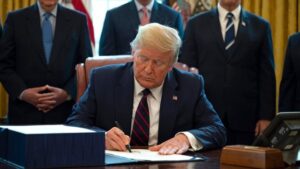
The volume of industrial production in Germany in February decreased by 1.3% compared to the previous month, according to the country’s statistical office. Analysts on average expected a 1.1% decline, according to Trading Economics.
Following the revision, the estimate of industrial production growth in January was confirmed at 2%.
The decline in industrial production in February was primarily due to a 3.2% decline in the construction industry, the department said. Food production decreased by 5.3% and energy production by 3.3%.
Meanwhile, the output of electrical equipment increased by 3.3%. The output of capital goods increased by 0.2%, consumer goods decreased by 3%, and intermediate goods by 0.4%. In annual terms, industrial production in Germany fell by 4% in February.
http://relocation.com.ua/promvyrobnytstvo-v-nimechchyni-v-liutomu-znovu-skorotylosia/

The National Bank of Ukraine has revoked the financial services licenses of six non-banking financial institutions and excluded them from the State Register of Financial Institutions.
According to the regulator’s website, this applies to FC BI.Money LLC and Rulla Ukraine LLC, which provided funds and bank metals on credit, Prostozaym LLC, State Enterprise Ukrainian Center Security, State Innovative Financial and Credit Institution – Financial Leasing, PO Lombard Onyx Plus Chernik and Company – provided funds and bank metals on credit in the form of pawn loans.
Another non-banking financial institution changed the scope of the license for the activity of a financial company.
In addition, on the basis of its own application LLC “Financial Company Liberty Finance” agreed to change the scope of the license for the activity of a financial company. Such financial services as factoring, financial leasing, provision of guarantees were excluded from it.
After changing the scope of the license, the company will have the right to carry out activities to provide financial services – the provision of funds and bank metals on credit, the activity of trading in foreign currency values in cash on the basis of the appropriate license for foreign exchange transactions.
The relevant decisions of the Committee on supervision and regulation of non-banking financial services markets adopted on April 3, 2025.

Insurance company Busin (Kyiv) in 2024 collected UAH 397.5 mln of gross premiums, which is 35.6% more than in 2023. This was reported by Standard-Rating in the information on updating of credit rating/rating of financial stability of the insurer at the level of “uaAA+” according to the national scale on the basis of the analysis for the outlined period. At the same time receipts from reinsurers have decreased by 26,64% – to UAH 31,677 mln.
Insurance payments sent to reinsurers for 2024 compared to 2023 have increased by 55,20% – up to UAH 301,021 mln. Thus, the ratio of reinsurers’ participation in insurance premiums has increased by 9.59 p.p. – up to 75,73%.
The company’s net premiums for 2024 amounted to UAH 96.457 mln, while net earned premiums amounted to UAH 40.325 mln.
Last year the company paid to its clients UAH 32,304 mln of insurance payments and indemnities, which is more than 24 times higher than the volume of insurance payments for the same period of 2023. Thus, the level of payouts increased by 7,68 p.p. – up to 8,13%.
Assets of the insurer on January 1, 2025 have decreased by 7,22% – to UAH 291,385 mln, shareholders’ equity has decreased by 19,94% – to UAH 157,908 mln, liabilities have increased by 14,26% – to UAH 133,477 mln, cash and cash equivalents have decreased by 0,35% – to UAH 253,783 mln.
IC Busin was registered in February, 1993. It specializes on risk types of insurance. It is a member of a number of professional and branch associations – League of Insurance Organizations of Ukraine, Insurance Payments Club, International Association of Aviation Insurers (UA), Nuclear Insurance Pool, American Chamber in Ukraine, British Business Club.

U.S. President Donald Trump on Saturday enacted 10% base tariffs on most imports, continuing his strategy of encouraging domestic investment and helping companies that seek to avoid import taxes, according to a Bloomberg report on Saturday.
Although the base duty is already starting to apply, for some countries the higher duties, which replace rather than add to the prime rate, will take effect April 9.
These new tariffs raised U.S. duties to the highest level in more than a century, dealing a major blow to the global trading system that emerged after World War II and which Trump has long called unfair, the publication reported.
The U.S. president’s statement sent U.S. stocks plummeting, with the S&P 500 index plunging to its lowest level in 11 months, losing $5.4 trillion in market value in just two trading sessions to end the week. It was the biggest two-day drop since the U.S. pandemic began in March 2020.
Afterward, Trump said he was willing to cut duties if other countries offered him something “phenomenal”.

On April 3, the Finance Ministry announced a tender for voluntary insurance of motor vehicles (CASCO), according to the Prozorro e-procurement system.
The total expected cost of the service is 143 thousand UAH. The last day for accepting bids is April 11.